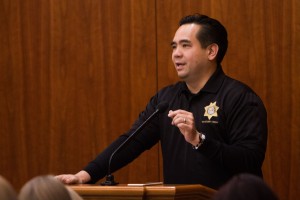
Fifteen to 40 million victims suffer from human trafficking worldwide today, according to Utah Attorney General Sean Reyes. He explained this statistic is especially staggering because comparatively the transatlantic slave trade victimized 12 to 13 million people over a 300-year span.
Reyes spoke at BYU on Saturday, Jan.9, 2016. He shared many examples of human trafficking cases that have occurred. The event was sponsored by BYU Women, a 120 years old organization, to shed light on human trafficking and to raise awareness about what people can do to help stop it.
Reyes said people often think of human trafficking as a worldwide problem. Human trafficking happens everywhere, even in Utah, according to Reyes. He shared numerous cases to illustrate this point. One of the biggest cases in history was that of Victor Rax.
In 2014, a friend told Reyes one of his friends was worried his son was being trafficked. Reyes quickly dispatched an investigation team that confirmed the human trafficking was occurring, which led to Rax’s arrest. Rax was an M13 gang member who had been deported seven times, but kept returning to run human trafficking organizations before finally being apprehended in West Valley.
This time they successfully delayed deportation in order to prosecute Rax in the United States. Ultimately, 60 victims came forward to testify against Rax. Rax eventually hung himself while in jail. The court continued on with the case to allow the victims closure and healing.
The Rax case outsized other human trafficking cases in Utah, but Reyes emphasized trafficking does occur and not just in rare instances.
“It’s prevalent, much more than people realize,” Reyes said.
The media often states human trafficking is hype or that it is merely politicians trying to save face. Reyes reiterated that this is a very real problem. He said the more he investigated human trafficking, the more he realized that the numbers are not hyped or exaggerated.
Reyes said human trafficking cases will often be tried under other charges in order to protect victims. The victims would be forced to testify if it were charged as human trafficking. He said human trafficking cases are often not publicly recognized as such, but this doesn’t mean they aren’t human trafficking cases.
Human trafficking happens in Utah and rural areas because people tend to be trusting, according to Reyes.
“It’s good to be trusting, but it’s also important to be wise,” Reyes said.
He also shared a motto made famous by former President Ronald Reagan: “Trust, but verify.”
Reyes shared other examples where him and others were able to bust human trafficking organizations fronting as massage parlors from Weber to Utah county this past year. He also shared more details about his 2014 experience in Cartagena, Columbia working with Operation Underground Railroad (OUR). This was part of one of the sting operations in three cities that rescued 121 children.
He said the children started singing praises to their heroes when the sting ended. Reyes contrasted “that exhilaration and that joy” to the hopelessness he witnessed in the eyes of the two young girls who were about to be sold. He said the difference was “just an amazing thing.”
Reyes said he found reward not only in the initial rescue but also in the resulting change. He said one can no longer buy children in Cartagena because the traffickers fear apprehension.
He encouraged members to acknowledge this issue and to step forward if they see anything amiss. He concluded his lecture by stating his belief that through vigilance and commitment, human trafficking will come to an end.
Related Articles:
Local and Colombian government officials join to stop human trafficking
BYU club raises human trafficking awareness
‘The Abolitionist’ anti-sex trafficking film gets public premiere at BYU
Sex trafficking survivor tells her story at BYU




